-
 Afrikaans
Afrikaans -
 Albanian
Albanian -
 Amharic
Amharic -
 Arabic
Arabic -
 Armenian
Armenian -
 Azerbaijani
Azerbaijani -
 Basque
Basque -
 Belarusian
Belarusian -
 Bengali
Bengali -
 Bosnian
Bosnian -
 Bulgarian
Bulgarian -
 Catalan
Catalan -
 Cebuano
Cebuano -
 China
China -
 Corsican
Corsican -
 Croatian
Croatian -
 Czech
Czech -
 Danish
Danish -
 Dutch
Dutch -
 English
English -
 Esperanto
Esperanto -
 Estonian
Estonian -
 Finnish
Finnish -
 French
French -
 Frisian
Frisian -
 Galician
Galician -
 Georgian
Georgian -
 German
German -
 Greek
Greek -
 Gujarati
Gujarati -
 Haitian Creole
Haitian Creole -
 hausa
hausa -
 hawaiian
hawaiian -
 Hebrew
Hebrew -
 Hindi
Hindi -
 Miao
Miao -
 Hungarian
Hungarian -
 Icelandic
Icelandic -
 igbo
igbo -
 Indonesian
Indonesian -
 irish
irish -
 Italian
Italian -
 Japanese
Japanese -
 Javanese
Javanese -
 Kannada
Kannada -
 kazakh
kazakh -
 Khmer
Khmer -
 Rwandese
Rwandese -
 Korean
Korean -
 Kurdish
Kurdish -
 Kyrgyz
Kyrgyz -
 Lao
Lao -
 Latin
Latin -
 Latvian
Latvian -
 Lithuanian
Lithuanian -
 Luxembourgish
Luxembourgish -
 Macedonian
Macedonian -
 Malgashi
Malgashi -
 Malay
Malay -
 Malayalam
Malayalam -
 Maltese
Maltese -
 Maori
Maori -
 Marathi
Marathi -
 Mongolian
Mongolian -
 Myanmar
Myanmar -
 Nepali
Nepali -
 Norwegian
Norwegian -
 Norwegian
Norwegian -
 Occitan
Occitan -
 Pashto
Pashto -
 Persian
Persian -
 Polish
Polish -
 Portuguese
Portuguese -
 Punjabi
Punjabi -
 Romanian
Romanian -
 Russian
Russian -
 Samoan
Samoan -
 Scottish Gaelic
Scottish Gaelic -
 Serbian
Serbian -
 Sesotho
Sesotho -
 Shona
Shona -
 Sindhi
Sindhi -
 Sinhala
Sinhala -
 Slovak
Slovak -
 Slovenian
Slovenian -
 Somali
Somali -
 Spanish
Spanish -
 Sundanese
Sundanese -
 Swahili
Swahili -
 Swedish
Swedish -
 Tagalog
Tagalog -
 Tajik
Tajik -
 Tamil
Tamil -
 Tatar
Tatar -
 Telugu
Telugu -
 Thai
Thai -
 Turkish
Turkish -
 Turkmen
Turkmen -
 Ukrainian
Ukrainian -
 Urdu
Urdu -
 Uighur
Uighur -
 Uzbek
Uzbek -
 Vietnamese
Vietnamese -
 Welsh
Welsh -
 Bantu
Bantu -
 Yiddish
Yiddish -
 Yoruba
Yoruba -
 Zulu
Zulu
hail protection net
The Importance of Hail Protection Nets Safeguarding Crops and Livelihoods
Hailstorms can be devastating for agricultural producers and homeowners alike. In a matter of minutes, a hailstorm can ruin crops, damage property, and lead to significant economic losses. As extreme weather conditions become more frequent and severe due to climate change, effective protective measures are crucial. One of the most effective solutions for safeguarding crops is the use of hail protection nets.
Hail protection nets are specially designed to shield crops from hail damage while allowing sunlight and rain to nourish the plants. Made from high-density polyethylene (HDPE) or similar materials, these nets are lightweight yet incredibly strong, providing a physical barrier against falling hailstones. The structure of the net is typically installed above crops, creating a protective canopy that absorbs and diffuses the impact of hailstones.
Benefits of Hail Protection Nets
1. Crop Preservation The primary benefit of hail protection nets is the preservation of crops. Farmers invest a significant amount of time, effort, and resources into growing their produce. A hailstorm can wipe out an entire season's work in just a few moments. By implementing hail nets, farmers can drastically reduce the risk of crop loss, ensuring their investments are protected.
2. Increased Yield By protecting crops from extreme weather conditions, farmers can also expect to see an increase in overall yield. When plants are safeguarded against hail, they have a higher chance of reaching maturity and producing a bountiful harvest. This can lead to improved supply and better profitability for growers, helping to stabilize local economies.
3. Pest and Disease Control Hail protection nets can also serve as a barrier against certain pests and diseases. By creating a controlled environment, these nets help reduce the exposure of crops to harmful insects and pathogens, thus supporting healthier plants and decreasing the need for chemical pesticides.
hail protection net

4. Versatility and Customization Hail protection nets come in various sizes, strengths, and colors, allowing farmers to customize the installation based on their specific needs. Whether shielding fruit trees, vineyards, or vegetable crops, these nets can be tailored to fit different agricultural settings, ensuring maximum protection.
5. Sustainability The use of hail protection nets promotes sustainable farming practices. By minimizing crop loss and chemical usage, they contribute to a more environmentally friendly approach to agriculture. Furthermore, these nets can be recycled, reducing waste and promoting circular economy principles.
Installation and Maintenance
Installing hail protection nets requires careful planning and execution. Farmers should consider factors such as the type of crops, local weather patterns, and potential hailstone sizes when designing their protection strategy. Professional installation may be recommended to ensure that nets are secured properly and can withstand strong winds and other weather challenges.
Once installed, maintenance is relatively straightforward. Regular inspections should be conducted to check for any damage caused by environmental factors or pests. Additionally, ensuring that the nets are cleaned and free from debris can enhance their longevity and effectiveness.
Conclusion
As climate-related challenges continue to impact agriculture, the importance of effective protective measures becomes increasingly evident. Hail protection nets represent a proactive approach to reduce losses and enhance the resilience of farming operations. By investing in this technology, farmers can protect their crops, secure their livelihoods, and contribute to a more sustainable agricultural future. In an era where adaptability and resilience are paramount, hail protection nets prove to be a worthy investment for those looking to weather the storms ahead.
-
Shipping Plastic Bags for Every NeedNewsJul.24,2025
-
Safety Netting: Your Shield in ConstructionNewsJul.24,2025
-
Plastic Mesh Netting for Everyday UseNewsJul.24,2025
-
Nylon Netting for Every UseNewsJul.24,2025
-
Mesh Breeder Box for Fish TanksNewsJul.24,2025
-
Expanded Steel Mesh Offers Durable VersatilityNewsJul.24,2025











